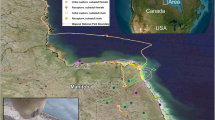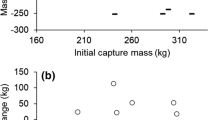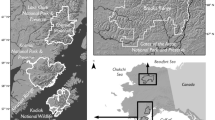Abstract
Plasticity in the physiological and behavioural responses of animals to prolonged food shortages may determine the persistence of species under climate warming. This is particularly applicable for species that can “adaptively fast” by conserving protein to protect organ function while catabolizing endogenous tissues. Some Ursids, including polar bears (Ursus maritimus), adaptively fast during winter hibernation—and it has been suggested that polar bears also employ this strategy during summer. We captured 57 adult female polar bears in the Southern Beaufort Sea (SBS) during summer 2008 and 2009 and measured blood variables that indicate feeding, regular fasting, and adaptive fasting. We also assessed tissue δ13C and δ15N to infer diet, and body condition via mass and length. We found that bears on shore maintained lipid and protein stores by scavenging on bowhead whale (Balaena mysticetus) carcasses from human harvest, while those that followed the retreating sea ice beyond the continental shelf were food deprived. They had low ratios of blood urea to creatinine (U:C), normally associated with adaptive fasting. However, they also exhibited low albumin and glucose (indicative of protein loss) and elevated alanine aminotransferase and ghrelin (which fall during adaptive fasting). Thus, the ~ 70% of the SBS subpopulation that spends summer on the ice experiences more of a regular, rather than adaptive, fast. This fast will lengthen as summer ice declines. The resulting protein loss prior to winter could be a mechanism driving the reported correlation between summer ice and polar bear reproduction and survival in the SBS.







Similar content being viewed by others
References
Amstrup SC, Marcot BG, Douglas DC (2008) A Bayesian network modeling approach to forecasting the 21 century worldwide status of polar bears. In: Deweaver ET, Bitz CM, Tremblay LB (eds) Arctic sea ice decline: observations, projections, mechanisms, and implications. American Geophysical Union, Washington, DC, pp 213–268
Arnould JPY (1990) The energetics of lactation in polar bears. PhD thesis, University of Saskatchewan
Atkinson SN, Nelson RA, Ramsay MA (1996) Changes in the body composition of fasting polar bears (Ursus maritimus): the effect of relative fatness on protein conservation. Physiol Zool 69:304–316
Atwood TC, Peacock EM, McKinney MA et al (2015) Demographic composition and behavior of polar bears summering on shore in Alaska. US Geological Survey, Anchorage
Atwood TC, Peacock E, McKinney MA et al (2016) Rapid environmental change drives increased land use by an Arctic marine predator. PLoS ONE 11:e0155932. https://doi.org/10.1371/journal.pone.0155932
Ballantyne FC, Smith J, Fleck A (1973) Albumin metabolism in fasting, obese subjects. Br J Nutr 30:585–592. https://doi.org/10.1079/BJN19730065
Barboza PS, Farley SD, Robbins CT (1997) Whole-body urea cycling and protein turnover during hyperphagia and dormancy in growing bears (Ursus americanus and U. arctos). Can J Zool 75:2129–2136
Barnhart KR, Miller CR, Overeem I, Kay JE (2015) Mapping the future expansion of Arctic open water. Nat Clim Change 6:280–285. https://doi.org/10.1038/nclimate2848
Bates D, Maechler M, Bolker B, Walker S (2014) lme4: linear mixed-effects models using Eigen and S4. http://CRAN.R-project.org/package=lme4. Accessed 15 Sep 2014
Baumgartner RN, Koehler KM, Romero L, Garry PJ (1996) Serum albumin is associated with skeletal muscle in elderly men and women. Am J Clin Nutr 64:552–558
Bender LC, Cook JG, Cook RC, Hall PB (2008) Relations between nutritional condition and survival of North American elk Cervus elaphus. Wildl Biol 14:70–80. https://doi.org/10.2981/0909-6396(2008)14[70:RBNCAS]2.0.CO;2
Boutin S, Lane JE (2014) Climate change and mammals: evolutionary versus plastic responses. Evol Appl 7:29–41. https://doi.org/10.1111/eva.12121
Brody T (1999) Nutritional biochemistry, vol 2. Academic Press, Berkeley
Burns JJ (1981) Bearded seal. Handbook of marine mammals. Academic Press, New York, pp 145–170
Calvert W, Ramsay MA (1998) Evaluation of age determination of polar bears by counts of cementum growth layer groups. Ursus 10:449–453
Canale CI, Henry PY (2010) Adaptive phenotypic plasticity and resilience of vertebrates to increasing climatic unpredictability. Clim Res 43:135–147
Castellini MA, Rea LD (1992) The biochemistry of natural fasting at its limits. Experientia 48:575–582
Cattet MRL, Caulkett NA, Obbard ME, Stenhouse GB (2002) A body-condition index for ursids. Can J Zool 80:1156–1161
Caut S, Angulo E, Courchamp F (2009) Variation in discrimination factors (Δ15N and Δ13C): the effect of diet isotopic values and applications for diet reconstruction. J Appl Ecol 46:443–453. https://doi.org/10.1111/j.1365-2664.2009.01620.x
Cherry SG, Derocher AE, Hobson KA et al (2011) Quantifying dietary pathways of proteins and lipids to tissues of a marine predator. J Appl Ecol 48:373–381
Cook JG, Johnson BK, Cook RC et al (2004) Effects of summer–autumn nutrition and parturition date on reproduction and survival of elk. Wildl Monogr 155:1–61. https://doi.org/10.2307/3830773
Derocher AE, Stirling I (1998) Geographic variation in growth of polar bears (Ursus maritimus). J Zool 245:65–72. https://doi.org/10.1111/j.1469-7998.1998.tb00072.x
Derocher AE, Nelson RA, Stirling I, Ramsay MA (1990) Effects of fasting and feeding on serum urea and serum creatinine levels in polar bears. Mar Mamm Sci 6:196–203
Durner GM, Douglas DC, Nielson RM et al (2009) Predicting 21st-century polar bear habitat distribution from global climate models. Ecol Monogr 79:25–58. https://doi.org/10.2307/27646165
Farley SD, Robbins CT (1994) Development of 2 methods to estimate body-composition of bears. Can J Zool 72:220–226
Gardi J, Nelson OL, Robbins CT et al (2011) Energy homeostasis regulatory peptides in hibernating grizzly bears. Gen Comp Endocrinol 172:181–183
Habold C, Foltzer-Jourdainne C, Maho YL et al (2005) Intestinal gluconeogenesis and glucose transport according to body fuel availability in rats. J Physiol 566:575–586. https://doi.org/10.1113/jphysiol.2005.085217
Harlow HJ (2012) Muscle protein and strength retention by bears during winter fasting and starvation. In: McCue MD (ed) Comparative physiology of fasting, starvation, and food limitation. Springer, Berlin, pp 277–296
Harlow HJ, Beck TDI, Walters LM, Greenhouse SS (1990) Seasonal serum glucose, progesterone, and cortisol-levels of black bears (Ursus americanus). Can J Zool 68:183–187
Harwood LA, Smith TG, Auld JC (2012) Fall migration of ringed seals (Phoca hispida) through the Beaufort and Chukchi Seas, 2001–02. Arctic 65:35–44
Healy JE, Ostrom CE, Wilkerson GK, Florant GL (2010) Plasma ghrelin concentrations change with physiological state in a sciurid hibernator (Spermophilus lateralis). Gen Comp Endocrinol 166:372–378
Hellgren EC (1998) Physiology of hibernation in bears. Ursus 10:467–477
Herminghuysen D, Vaughan M, Pace RM et al (1995) Measurement and seasonal variations of black bear adipose lipoprotein lipase activity. Physiol Behav 57:271–275
Hoffenberg R, Black E, Brock JF (1966) Albumin and gamma-globulin tracer studies in protein depletion states. J Clin Invest 45:143–152. https://doi.org/10.1172/JCI105319
Hubert M-F, Laroque P, Gillet J-P, Keenan KP (2000) The effects of diet, ad libitum feeding, and moderate and severe dietary restriction on body weight, survival, clinical pathology parameters, and cause of death in control Sprague–Dawley rats. Toxicol Sci 58:195–207. https://doi.org/10.1093/toxsci/58.1.195
Iqbal J, Hussain MM (2009) Intestinal lipid absorption. Am J Physiol Endocrinol Metab 296:E1183–E1194
Kalxdorff SB (1998) Distribution and abundance of marine mammal carcasses along beaches of the Bering, Chukchi, and Beaufort Seas, Alaska, 1995–1997. Marine Mammals Management, U.S. Fish and Wildlife Service, Anchorage
Klein S, Sakurai Y, Romijn JA, Carroll RM (1993) Progressive alterations in lipid and glucose metabolism during short-term fasting in young adult men. Am J Physiol Endocrinol Metab 265:E801–E806
Kojima M, Kangawa K (2010) Ghrelin: from gene to physiological function. Results Probl Cell Differ 50:185–205
LeBlanc PJ, Obbard M, Battersby BJ et al (2001) Correlations of plasma lipid metabolites with hibernation and lactation in wild black bears Ursus americanus. J Comp Physiol B Biochem Syst Environ Physiol 171:327–334
Lohuis TD, Beck TDI, Harlow HJ (2005) Hibernating black bears have blood chemistry and plasma amino acid profiles that are indicative of long-term adaptive fasting. Can J Zool 83:1257–1263
McCain CM, King SRB (2014) Body size and activity times mediate mammalian responses to climate change. Glob Change Biol 20:1760–1769. https://doi.org/10.1111/gcb.12499
Molnár PK, Klanjscek T, Derocher AE et al (2009) A body composition model to estimate mammalian energy stores and metabolic rates from body mass and body length, with application to polar bears. J Exp Biol 212:2313–2323
Morris HJ, Carrillo OV, Llauradóó G et al (2011) Effect of starvation and refeeding on biochemical and immunological status of Balb/c mice: an experimental model of malnutrition. Immunopharmacol Immunotoxicol 33:438–446. https://doi.org/10.3109/08923973.2010.531732
Nelson RA, Wahner HW, Jones JD et al (1973) Metabolism of bears before, during, and after winter sleep. Am J Physiol 224:491–496
Nelson RA, Folk GE, Pfeiffer EW et al (1983) Behavior, biochemistry and hibernation in black, grizzly and polar bears. Ursus 5:284–290
Nelson RA, Beck TDI, Steiger DL (1984) Ratio of serum urea to serum creatinine in wild black bears. Science 226:841–842
Nelson OL, Jansen HT, Galbreath E et al (2014) Grizzly bears exhibit augmented insulin sensitivity while obese prior to a reversible insulin resistance during hibernation. Cell Metab 20:376–382. https://doi.org/10.1016/j.cmet.2014.07.008
Nordøy ES, Aakvaag A, Larsen TS (1993) Metabolic adaptations to fasting in Harp seal pups. Physiol Zool 66:926–945
Notz D, Stroeve J (2016) Observed Arctic sea-ice loss directly follows anthropogenic CO2 emission. Science 354:747–750. https://doi.org/10.1126/science.aag2345
NSIDC (2016) National snow & ice data center. In: National Snow and Ice Data Center. http://nsidc.org/arcticseaicenews/. Accessed 12 Jan 2016
Owen OE, Smalley KJ, D’Alessio DA et al (1998) Protein, fat, and carbohydrate requirements during starvation: anaplerosis and cataplerosis. Am J Clin Nutr 68:12–34
Pilfold NW, Derocher AE, Stirling I, Richardson E (2015) Multi-temporal factors influence predation for polar bears in a changing climate. Oikos 124:1098–1107. https://doi.org/10.1111/oik.02000
Polischuk SC, Hobson KA, Ramsay MA (2001) Use of stable-carbon and -nitrogen isotopes to assess weaning and fasting in female polar bears and their cubs. Can J Zool 79:499–511
Pongracz JD, Derocher AE (2017) Summer refugia of polar bears (Ursus maritimus) in the southern Beaufort Sea. Polar Biol 40:753–763
Porterfield SP (2001) Endocrine Physiology, vol 2. Mosby, St. Louis
Ramsay MA, Nelson RA, Stirling I (1991) Seasonal changes in the ratio of serum urea to creatinine in feeding and fasting polar bears. Can J Zool 69:298–302
R Core Team (2015) R: a language and environment for statistical computing. R Foundation for Statistical Computing, Vienna
Regehr EV, Hunter CM, Caswell H et al (2010) Survival and breeding of polar bears in the southern Beaufort Sea in relation to sea ice. J Anim Ecol 79:117–127
Rode KD, Robbins CT, Nelson L, Amstrup SC (2015) Can polar bears use terrestrial foods to offset lost ice-based hunting opportunities? Front Ecol Environ 13:138–145. https://doi.org/10.1890/140202
Rode KD, Stricker CA, Erlenbach J et al (2016) Isotopic incorporation and the effects of fasting and dietary lipid content on isotopic discrimination in large carnivorous mammals. Physiol Biochem Zool 89:182–197. https://doi.org/10.1086/686490
Rogers MC, Peacock E, Simac K et al (2015) Diet of female polar bears in the southern Beaufort Sea of Alaska: evidence for an emerging alternative foraging strategy in response to environmental change. Polar Biol 38:1035–1047. https://doi.org/10.1007/s00300-015-1665-4
Schliebe S, Rode KD, Gleason JS et al (2008) Effects of sea ice extent and food availability on spatial and temporal distribution of polar bears during the fall open-water period in the Southern Beaufort Sea. Polar Biol 31:999–1010. https://doi.org/10.1007/s00300-008-0439-7
Schroeder MT (1987) Blood chemistry, hematology, and condition evaluation of black bears in north coastal California. Int Conf Bear Res Manag 7:333–349
Schutz Y, Ravussin E (1980) Respiratory quotients lower than 0.70 in ketogenic diets. Am J Clin Nutr 33:1317–1319
Shephard RJ (2012) A critical examination of the Douglas bag technique. Med Sci Sports Exerc 44:1407. https://doi.org/10.1249/MSS.0b013e318253b1c3
Stenvinkel P, Fröbert O, Anderstam B et al (2013) Metabolic changes in summer active and anuric hibernating free-ranging brown bears (Ursus arctos). PLoS ONE 8:e72934. https://doi.org/10.1371/journal.pone.0072934
Stern HL, Laidre KL (2016) Sea-ice indicators of polar bear habitat. Cryosphere 10:2027–2041
Stirling I, Archibald WR (1977) Aspects of predation of seals by polar bears. J Fish Res Board Can 34:1126–1129
Stirling I, Derocher AE (2012) Effects of climate warming on polar bears: a review of the evidence. Glob Change Biol 18:2694–2706. https://doi.org/10.1111/j.1365-2486.2012.02753.x
Stirling I, Spencer C, Andriashek D (1989) Immobilization of polar bears (Ursus maritimus) with Telazol in the Canadian Arctic. J Wildl Dis 25:159–168
Stock BC, Semmens BX (2015) MixSIAR. https://github.com/brianstock/MixSIAR/. Accessed 29 Oct 2015
Storey KB, Storey JM (2010) Metabolic rate depression: the biochemistry of mammalian hibernation. Adv Clin Chem 52:77–108
Thompson CS, Mikhailidis DP, Gill DS et al (1989) Effect of starvation and sampling time on plasma alkaline phosphatase activity and calcium homeostasis in the rat. Lab Anim 23:53–58
Tøien Ø, Blake J, Edgar DM et al (2011) Hibernation in black bears: independence of metabolic suppression from body temperature. Science 331:906–909
Vander Zanden MJ, Clayton MK, Moody EK et al (2015) Stable isotope turnover and half-life in animal tissues: a literature synthesis. PLoS ONE 10:e0116182. https://doi.org/10.1371/journal.pone.0116182
Visser ME, Both C (2005) Shifts in phenology due to global climate change: the need for a yardstick. Proc Biol Sci 272:2561–2569
Walsberg G, Wolf B (1995) Variation in the respiratory quotient of birds and implications for indirect calorimetry using measurements of carbon dioxide production. J Exp Biol 198:213–219
Wang T, Hung CCY, Randall DJ (2006) The comparative physiology of food deprivation: from feast to famine. Annu Rev Physiol 68:223–251
Watts PD, Hansen SE (1987) Cyclic starvation as a reproductive strategy in the polar bear. Symp Zool Soc Lond 57:306–318
Whiteman JP, Greller KA, Harlow HJ et al (2012) Carbon isotopes in exhaled breath track metabolic substrates in brown bears (Ursus arctos). J Mamm 93:413–421
Whiteman JP, Harlow HJ, Durner GM et al (2015) Summer declines in activity and body temperature offer polar bears limited energy savings. Science 349:295–298. https://doi.org/10.1126/science.aaa8623
Whiteman JP, Rourke BC, Robles M et al (2017) Polar bears experience skeletal muscle atrophy in response to food deprivation and reduced activity in winter and summer. Conserv Physiol 5:1. https://doi.org/10.1093/conphys/cox049
Xu C, He JH, Jiang HF et al (2009) Direct effect of glucocorticoids on lipolysis in adipocytes. Mol Endocrinol 23:1161–1170
Acknowledgements
Geoff York, Kristin Simac, Anthony Pagano, Katie Cheesbrough, Clark Cotton, Dana Peterson, staff of Prism Helicopters and Maritime Helicopters, and the officers and crew of the USCGC Polar Sea helped with data collection. Matthew Kauffman, Robert Hall, Michael Liebman, and reviewers improved this manuscript. This report was not reviewed by the EPA; it was approved under USGS Fundamental Science Practices. The views of the USFWS authors in this publication are solely those of the USFWS authors, and do not necessarily represent the views of the USFWS. Funding was provided by National Science Foundation (OPP 0732713), USGS Climate and Land Use Change Research and Development, US Fish and Wildlife Service Marine Mammals Management, US EPA STAR Graduate Fellowship (F91737301), Wyoming NASA Space Grant Graduate Fellowship (NNG05G165H), and the University of Wyoming. Procedures were approved by IACUC at the University of Wyoming and USGS Alaska Science Center, and permitted by US Fish and Wildlife Service (MA690038). The authors declare no conflicts of interest. Any use of trade, firm, or product names is for descriptive purposes only and does not imply endorsement by the U.S. Government or any other institution affiliated with the authors. Data are archived by NCAR (http://www.eol.ucar.edu/projects/arcss/).
Author information
Authors and Affiliations
Contributions
JPW, HJH, GMD, EVR, SCA, and MBD formulated the ideas and conducted fieldwork, JPW conducted lab analyses, JPW and MBD performed statistical analyses, JPW, HJH, GMD, EVR, SCA, and MBD wrote the manuscript.
Corresponding author
Additional information
Communicated by Anders Angerbjörn.
Electronic supplementary material
Below is the link to the electronic supplementary material.
Rights and permissions
About this article
Cite this article
Whiteman, J.P., Harlow, H.J., Durner, G.M. et al. Phenotypic plasticity and climate change: can polar bears respond to longer Arctic summers with an adaptive fast?. Oecologia 186, 369–381 (2018). https://doi.org/10.1007/s00442-017-4023-0
Received:
Accepted:
Published:
Issue Date:
DOI: https://doi.org/10.1007/s00442-017-4023-0




